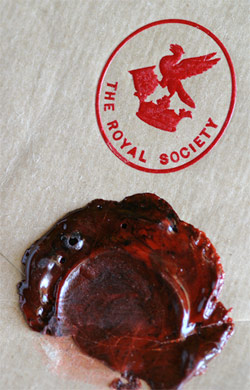This article is more than 1 year old
Royal Society unearths top secret nuclear research
Only 66 years late
The British government sent the papers on to the Royal Society, but not before leaving them to moulder on a shelf for a while. Peter Blackett, then a scientific adviser to the Ministry of Supply, and later a president of the Royal Society, wrote a covering letter in November of 1940:
"I enclose four short papers on questions concerning uranium fission...owing to the necessity of secrecy, they couldn't be published..."
After this rather stern admonishment, reminding the recipient of the importance of the research, he adds: "I fear I forgot about them for some months and have only now come across them again."
Blackett later said that if it had not been for the war, nuclear power would have been a French invention.

Chadwick's thumbprint - early biometrics?
While the early papers, written in French, have clearly come to the Royal Society from the British Government, others are in English, and were sent directly to James Chadwick who deposited them for safe keeping. These are sealed with with an impression of the great man's own thumb in red wax. [Early biometrics, you might say - Ed]
Chadwick also stressed the importance of secrecy, writing on 18 December, 1941: "I enclose..a paper entitled Technological Aspects of Nuclear Chain Reactions used as a Source of Power. The paper is such that it would be inadvisable to publish at the present time."
As to why the researchers would send the papers to Chadwick, and then on to the Royal Society, Moore says the scientists were not able to publish their work, but still wanted to make sure they could claim the discoveries as their own. He adds that this is in the oldest traditions of the society.
Dr Brian Cox, a particle physicist working at CERN, commented: "I can see why these papers were locked away during the war - they contain details that could be used to build a nuclear reactor."
Cox says the papers also provide an insight into "the inquisitive nature of scientists working in a field that was moving so rapidly it was almost outpacing them. It is fascinating to read their views on what might come of their research, and how accurate some of their predictions have been".
For instance, the two men hypothesise (correctly as it turns out) that a future industry of nuclear power would rely on uranium as its main fuel.
But what is also striking is what is missing: terminology that we might be used to today, the jargon of nuclear power. A nuclear reactor is referred to as "the boiler" throughout the papers. The moderator, material used to slow neutrons down, encouraging more of a manageable chain reaction and less of an explosion, is rather charmingly called "slowing-down material".
The intention was always that the papers would be unsealed and published after the war. But the pace of research was such that any ideas in the papers would have been quickly superseded. Cold War tensions could also have prevented their disclosure, Moore says. ®
